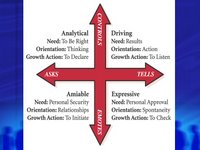Here are some descriptors around the social styles that we discussed in a previous blog. Just to remind you, the horizontal axis that runs through the middle of the grid is Assertiveness - which is "The perceived effort that a person makes to influence others" - The vertical axis represents Responsiveness - which is "The perceived freedom with which a person shows his or her feelings or responds to the feelings of others" Someone who is perceived as "Tell" Assertive would be seen as "More" Assertive and someone who was "Ask" Assertive would be seen as "Less" Assertive.
Someone who is perceived as "Tell" Assertive would be seen as "More" Assertive and someone who was "Ask" Assertive would be seen as "Less" Assertive.
 Someone who is perceived as "Tell" Assertive would be seen as "More" Assertive and someone who was "Ask" Assertive would be seen as "Less" Assertive.
Someone who is perceived as "Tell" Assertive would be seen as "More" Assertive and someone who was "Ask" Assertive would be seen as "Less" Assertive.On the Responsive scale. At the top end "Controls" would be seen as "Less" Emotionally Responsive (Cooler) while someone at the bottom end "Emotes" would be seen as "More" Emotionally Responsive (Warmer).
It should be noted that there is no one best place to be. Each style has it strengths and weaknesses.
For example, someone who is perceived as a Driving Style (More Assertive & Less Responsive) could be perceived as a Candid "Tell it like it is" type of person. If this strength was overused it may come across as Abrasive.
Someone who is perceived as an Expressive Style (More Assertive & More Responsive) could be perceived as Fun Loving "Life & soul of the party" type, which if overused could be seen as Irritating.
A strength of the Amiable Style (Less Assertive & More Responsive) is their Diplomacy, which overused could be perceived as a Conflict Avoider (some may say Wimp!)
The Analytical Style (Less Assertive & Less Responsive) is respected for their Systematic Approach which overused could come across as Bureaucratic.
The style that is diametrically opposed to your own is the one that will require you to exercise your people skills when influencing and responding to them.
The second slide indicates the primary need for each style, their orientation and their growth action or development need. (From Personal Styles & Effective Performance, by David Merrill and Roger Reid)




No comments:
Post a Comment